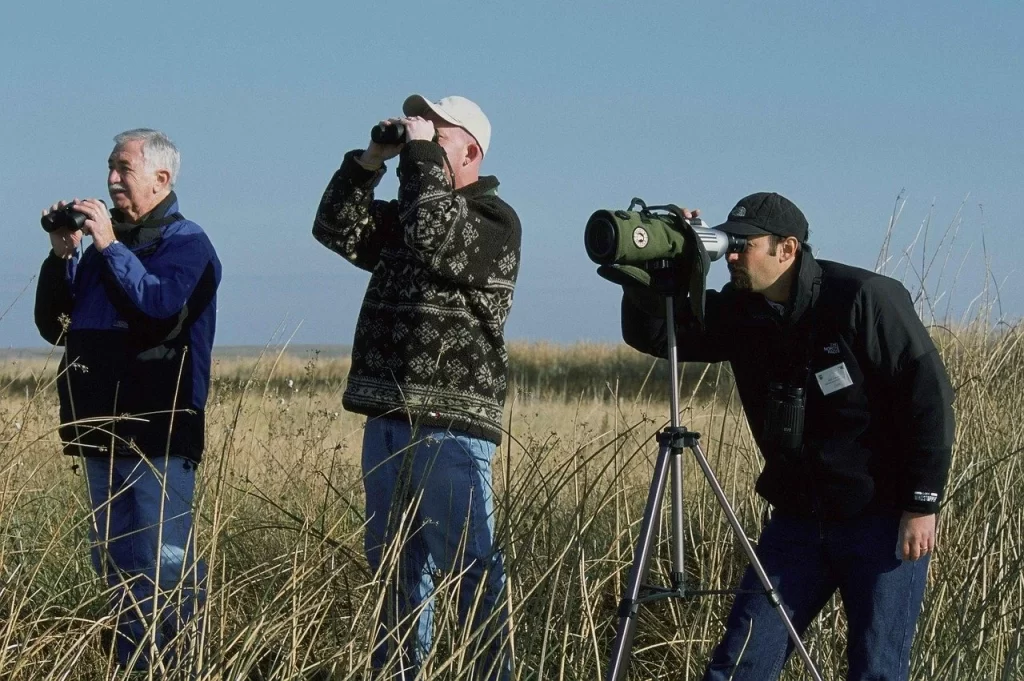
According to the USFWS, approximately 46.7 million Americans self-identify as birdwatchers. Although we do not have reliable data from various countries worldwide on this topic, the US numbers are staggering. The hobby is now gaining popularity by the day. Birding was once thought to be a retirement activity.
A typical birdwatcher is mostly depicted as a senior citizen in khakis moving slowly through country trails with a binocular around their neck and a notebook in hand. That is no longer the case. This healthy and addictive outdoor activity is now attracting many middle-aged and young people. With the display of their expensive cameras and long lenses, “the new generation bird photographers” project a more macho image. It is also true that they have elevated birding into something more technical and competitive outdoor activity.
This hobby does not necessitate any prior training or investment. You can start your birding adventure right away.
How can you get started on Bird Watching?
1. Seeing the first bird
Your birding adventure begins with that first bird. Take a deep breath, step out of your room, and go for a walk in the garden or nearby woods. Following a bird call will lead you to your first bird. Of course, you’ve seen birds in the garden, on the street, in parks, and so on. However, this would be your first time looking at a bird with a birder’s eye.
Congratulations. You’re a birder now.
Welcome to the ever-expanding world of bird watchers, also known as birders. You’ve overcome the most challenging barrier, procrastination, which impedes many of us from taking up this hobby.
2. Identifying the bird
The next step is to identify the bird you’ve seen. This is where you will learn the skills necessary to become a successful birder. When observing birds in the field, you must pay close attention to the size, shape, and length of the beak, feather colours, feeding patterns, and so on. Writing a brief description of the bird you just saw may come in handy when you’re sitting at your desk trying to identify it. To correctly identify a bird, you can search the internet, ask for help in one of the many Facebook groups dedicated to bird identification, or seek the help of a birder friend.
3. Purchasing a field guide
Take the birding breaks suggested above daily during the first week if possible. Every day, get out of your room and go for a short walk in the garden or woods to listen to bird calls, spot them, record the sighting, and identify them using your means and sources. Make plans to visit a nearby nature reserve or park early in the morning the following weekend. Bring a bottle of water and some cookies with you if you get tired or hungry on your adventure. I’m sure you’ll see more birds on such trips, but bird identification will become more enjoyable and complex. Birding would become more interesting when you began to keep a list of all the birds you identify, dubbed the “Life list” among the birders. Such a list will be the main impetus for you to become a serious birder.
You will gradually become more attracted to birding and take it seriously. so now is the time to make your first birding investment. A reference book. A field guide is a book that contains photographs of all the different types of birds seen in your country, identification guidelines, and other information that will keep you glued to the activity. I am confident that you will find a field guide to birds in the area on Amazon or in your local bookstore.
Your next purchase will be a pair of binoculars. In fact, it is the essential tool that any birder should have. They differed in price, weight, and magnification power. I suggest buying a high-quality 8 X 32 mm binocular, where the number 8 represents the number of times the image will be multiplied for you, and 32 mm represents the diameter of the lens. A higher diameter number indicates a larger front glass surface—more light enters the binoculars, resulting in a brighter image of the bird—but the trade-off is more weight.
Based on my field experience, I confidently recommend 8X32 mm as the ideal pair to rely on.
With a good pair of binoculars in hand and a field guide on your desk, you’re ready to take on the world of birding. The next logical step is to join a local birding club to make birding more regular and enjoyable.
What is the single known disadvantage of birding?
Most birders will develop a birding obsession that may last throughout life, sometimes, it can lead to excessive birding. Don’t worry. We’re all in.I’m glad you’re thinking about taking up this hobby. Give it a shot; I’m confident you’ll have a great time birding. We’ll see you on the field.32

